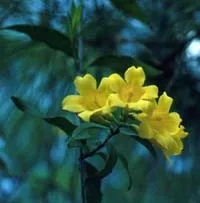NICE! Plant of the Month
(Gelsemium sempervirens)

Description:
Carolina Jessamine is an evergreen, perennial, flowering vine. Its natural range includes East Texas and much of the southeastern U.S. It produces fragrant, yellow, funnel-shaped flowers and is often one of the first plants to bloom in the spring. Gelsemium sempervirens has glossy green leaves 3″ long by 1″ wide on many-branched woody stems. The flowers are 1-1.5″ long, 1″ across, and have 5 deep lobes. Blooming period is from February through April and then for a short time in the fall. Carolina Jessamine is a nectar plant for the Spicebush Swallowtail butterfly; it also attracts honeybees. It is usually found growing in sunny woodlands or thickets.
Deer Resistance:
Carolina Jessamine is not usually browsed by deer and is listed as a deer tolerant plant in many plant references.
Planting Sites:
Carolina Jessamine is hardy from Zones 8 through 11. It has medium water requirements and can be planted in full sun or part shade. It’s adaptable to different soils ranging from its native sandy loam to black clay. In full sun and rich soil, the vine will flower abundantly and spread quickly, but it also grows in shade and poorer soil. It may need extra water in dry times. As with most vines, thick mulch or a large rock at the base of the plant keep roots cool and the plant flourishing. Carolina Jessamine is a high-climbing vine that will reach a height of 10 feet. It climbs by twining, and can be trained to grow on fences, walls, or other structures. It can also be used as a ground-cover.
Planting Instructions:
Dig a hole at least two times wider than, but the same depth as the root ball in the nursery container. Sides of the hole should be irregular, not smooth. Remove plant from container, taking care to support the root ball and avoid the spines. Loosen exterior roots gently with fingers. If the plant is root-bound, the outer roots may be cut in several places if they cannot be loosened by hand. Lift the plant by the root ball and place it in the hole. Backfill using soil that was dug from the hole. Do not add any soil to the top of the root ball, but a thin layer of compost may be spread over the soil surface. Gently firm the soil with hands, but do not tamp. Place 3-4 inches of mulch over the bare soil and root ball around the plant, but not touching the base of the plant.
Watering Instructions:
After planting, water deeply in order to settle soil around roots. An organic-based root stimulator may be used following instructions on the product label. Water deeply a couple of times a week for 2-4 weeks after planting, then every 7-10 days, as needed, during the first growing season. Check moisture an inch or two into soil at the edge of the root ball to determine soil moisture. Skip a watering after a rainfall of ½ to 1 inch. Maintain this watering schedule until the first fall. Reduce watering during fall and winter. In a “normal” year, no watering may be necessary during fall and winter, but during a dry period, monthly watering may be needed. From the second spring and throughout the second summer, water monthly only in periods of drought. Watering should be unnecessary after the plant is thoroughly established.
NICE! Tip:
A perennial, usually green year round, with springtime cascades of yellow flowers, Carolina Jessamine is easy to love. It can be used to cover a fence, wall, trellis or arbor, and will provide some shade in the landscape. Plant Carolina Jessamine instead of English ivy or annual non-native vines.
Look for the NICE! Plant of the Month signs and information sheets on your next visit to a participating Boerne nursery. And thank you for supporting native plants by using them in your landscapes.


